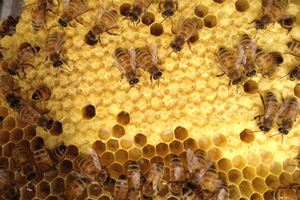- All-In-One Beekeeping for the Bees
- +1-608-728-8233
- info@beepods.com
The 4 Key Differences Between Urban and Rural Beekeeping


Interested in beekeeping, but don’t have a backyard or lush nature at your fingertips? No problem! Urban beekeeping is rising in popularity, and beekeepers have happy and healthy colonies on patios, rooftops, and other city spots around the world.
While urban and rural beekeepers have the same responsibilities to care for their bees, they deal with different environmental and logistical factors. Today, we’ll discuss the different factors urban and rural beekeepers manage as they approach caring for their hives.
Urban and Rural Beekeeping Benefits

A downtown rooftop is the perfect sunny setting for a Beepod.
While you might imagine bees buzzing around a meadow full of blossoms, you’d be surprised at how happy bees are to live in urban settings. They enjoy interesting food sources, bypass harsh chemicals found in agricultural areas, and pollinate gardens that support urban populations. Plus, urban beekeeping provides communities with opportunities to learn about bees and become comfortable with our favorite winged pollinators.
Rural beekeeping is the more traditional route enjoyed by beekeepers with access to outdoor properties. With more space, beekeepers have the opportunity to have more than one hive or to create their own bee yard. A significant upside of rural beekeeping is the often abundant plant life for bees. It also typically offers plenty of space for beekeepers to manage their hives away from larger groups of people. Bees kept in rural settings help nearby farms and agricultural operations to thrive and support local communities.
Siting Your Hive
Urban and rural beekeepers share some of the same basic hive-siting principles. Bees need good airflow, sunlight, forage, and water to survive and thrive. Whether you’re setting up a hive downtown or on a farm, you’ll want to make sure you have your bases covered when it comes to these important factors. Beepods’ Bee Yard Setup and Siting Blueprint is the best place to start.
Urban beekeepers need to be mindful of one resource their bees might not have easy access to: water. While cities often have water sources like fountains or rivers, they might not provide the fresh water bees need to thrive. Assess what clean, non-chlorinated water sources are near your desired hive site. If there aren’t any, make sure you provide them with one.
Rural beekeepers are more likely to place hives on grassy areas, hills, and other typically uneven ground. In this setting, leveling your hive is a crucial step to ensure your bees’ success. Check out our blog on level hives for tips to create an even foundation for your bees.
Urban and Rural Forage

Bees in urban settings can enjoy blossoms planted throughout their cities.
Urban bees feast on forage available to them in their environments. This might include the weeds and plants that grow in abandoned lots, blossoms grown on city sidewalks, and other urban plant growth. If you’re concerned about nearby forage for your bees, consider planting an urban garden.
Rural bees have access to more abundant forage. However, it’s essential to consider what food sources they’ll have during colder months. This might mean adding plants that bloom year-round to your yard or garden to ensure ongoing forage sources for your bees. The Sustainable Gardening Course in Beepods Lab has a ton of great tips for setting up, planting, and caring for a garden full of pollinator-friendly forage.
Hive Safety

Beepods feature locks on each side that protect bees (and their honey) from wildlife like bears.
Urban beekeepers have more neighbors and community members around, thus, fewer opportunities for hive vandals and robbers to discreetly steal or damage hives. With more people living and working near your hives, beekeepers also have a chance to educate their community about why bees are important and how we can live harmoniously with them.
Rural beekeepers must consider safety hazards such as the potential for pesticide exposure from local agricultural developments. Wildlife who enjoy bees’ honey (think bears and skunks) can be an issue in rural settings. Thankfully, the Beepods Beekeeping Complete System has a lock feature that protects the bees’ hard work from intruders.
Conclusion
Urban beekeeping and rural beekeeping each pose different considerations for beekeepers. However, both settings can provide wonderful homes for bees and excellent beekeeping environments for the people who care for them.
Kanoe Riedel
Latest posts by Kanoe Riedel (see all)
- This Spring, Don’t Forget Why Bees Are So Important to Our Environment - March 26, 2021
- 11 Awesome Uses for Your Stored Honeycomb - March 2, 2021
- How the Right Beekeeping Equipment Makes Inspections Better for Beekeepers and Bees - February 12, 2021



